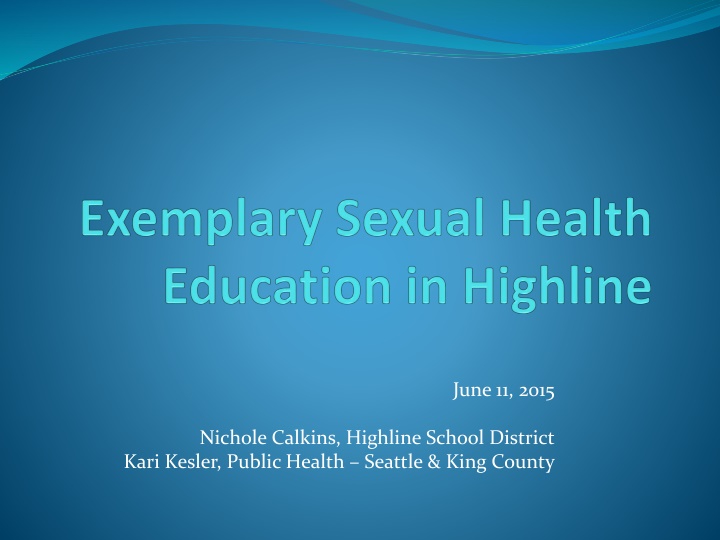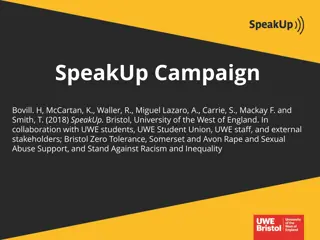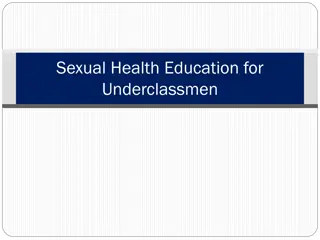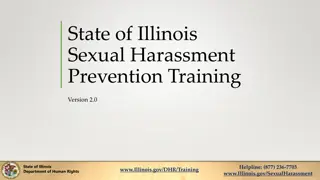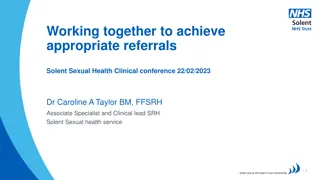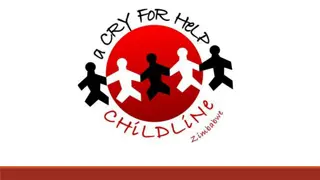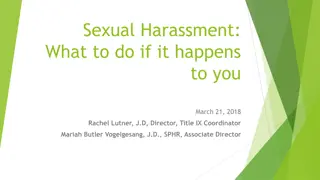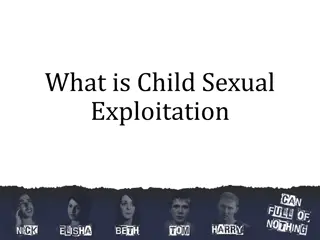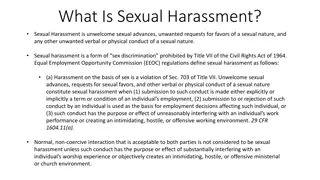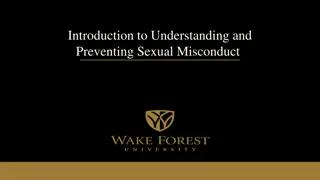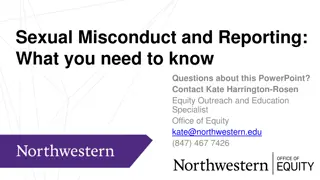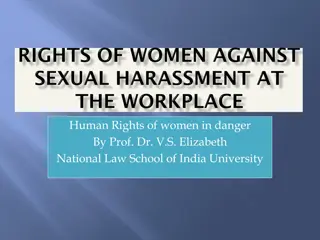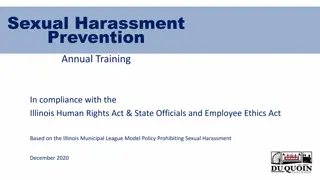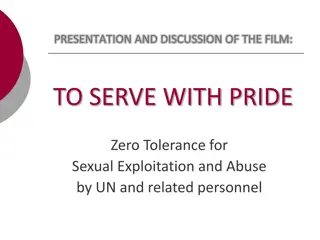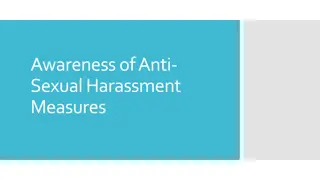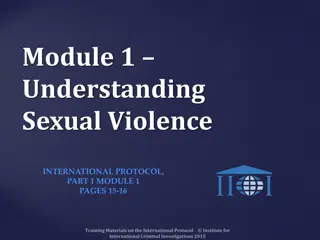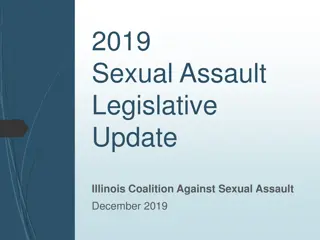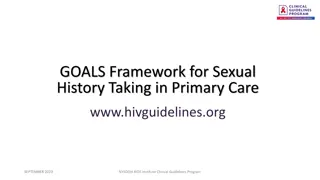Comprehensive Sexual Health Education: Objectives and Goals
This content delves into the objectives and goals of comprehensive sexual health education, focusing on safe and healthy practices. It outlines the importance of delivering accurate information aligned with standards, teaching in a supportive environment, and addressing challenging questions. Through discussions on the goal of sex education, exemplary sexual health education (ESHE), and outcomes of sexual health programs, the content aims to equip educators with the necessary knowledge and skills to promote positive sexual health behaviors among students.
Download Presentation

Please find below an Image/Link to download the presentation.
The content on the website is provided AS IS for your information and personal use only. It may not be sold, licensed, or shared on other websites without obtaining consent from the author.If you encounter any issues during the download, it is possible that the publisher has removed the file from their server.
You are allowed to download the files provided on this website for personal or commercial use, subject to the condition that they are used lawfully. All files are the property of their respective owners.
The content on the website is provided AS IS for your information and personal use only. It may not be sold, licensed, or shared on other websites without obtaining consent from the author.
E N D
Presentation Transcript
June 11, 2015 Nichole Calkins, Highline School District Kari Kesler, Public Health Seattle & King County
Agenda On Your Table of Contents: What is ESHE & Teacher Preparation Teacher Preparation & Information 1. Key Concepts Safe & Supportive Environments 2. Safe & Supportive Environments Lesson Planning & Content Delivery 3. Lessons Lesson Sneak Peeks 4. Laws & Policies Answering Student Questions 5. Resources Online Lesson Selection Tool
Todays Objectives Develop an understanding of how to deliver a comprehensive sexual health education unit that is aligned to standards and is medically and scientifically accurate Increase your understanding of how to create a safe and supportive environment for all students Increase your comfort and confidence in teaching gender identity and sexual orientation concepts Develop an understanding of laws pertaining to minors and sexual health education Increase your comfort and confidence in answering difficult and/or value-laden questions in the classroom
THE GOAL OF SEX EDUCATION: The goal of sex education is safe and healthy people. These are individuals who: Express love and intimacy in appropriate ways. Avoid exploitative or manipulative relationships. Recognize their own values and show respect for people with different values. Take responsibility for and understand the consequences of their own behavior. Communicate effectively with family, friends and partners. Talk with a partner about sexual activity before it occurs, including sexual limits (their own and their partner s), contraceptive and condom use, and meaning in the relationship.
Exemplary Sexual Health Education (ESHE): A systematic, evidence-informed approach to sexual health education that includes the use of grade-specific, evidence- based interventions, but also emphasizes sequential learning across elementary, middle, and high school grade levels. ESHE provides adolescents the essential knowledge and critical skills needed to avoid HIV, other STD, and unintended pregnancy. ESHE is delivered by well-qualified and trained teachers, uses strategies that are relevant and engaging, and consists of elements that are medically accurate, developmentally and culturally appropriate, and consistent with the scientific research on effective sexual health education.
Sexual Health Education Outcomes Independent reviews of the scientific evidence show that well-designed and well-implemented HIV/STD prevention programs are effective in decreasing sexual risk behaviors among youth. Specific outcomes include: Delaying first sexual intercourse Reducing the number of sex partners Decreasing the number of times students have unprotected sex Increasing condom use
Healthy Youth Survey Data Sexual behavior questions: o How old were you when you had sexual intercourse for the first time? (I have never had sexual intercourse; 11 years or younger; 12, 13, 14, 15, 16, 17 years old or older). o With how many people have you ever had sexual intercourse? (I have never had sexual intercourse; 1 person; 2 people, 3 people, 4 people, 5 people; 6 or more people) o The last time you had sexual intercourse, did you or your partner use a condom? (I have never had sexual intercourse, No, Yes)
Sexual Health Education Outcomes High quality, comprehensive sexual health education can reduce the likelihood that teens are involved in a pregnancy or acquire an STD or HIV. It may also be able to reduce sexual violence These outcomes are achieved by focusing on beliefs, attitudes, and skills at all ages.
Key Concepts Key concepts are the main ideas you re trying to convey in the lesson. Returning to your key concepts helps you stay focused and achieve the goals of the lesson.
Key Concept Guide Key concepts are derived from research on the behavioral goals of sexual health education Focus on beliefs, attitudes and skills related to sexual behavior. Less emphasis on knowledge alone. Based on age, level of development
Instructional Approach Focus on key concepts 1. Teach fewer sexual health facts 2. Use key concepts to frame sexual health information 3.
Key Concept Exercise Share your concept with others Check off the concepts you hear Check off at least 5 that you hear from others
Safe & Supportive Environments and ESHE The CDC recognizes that in addition to sexual health education, climate and safety in schools impact HIV, STD and pregnancy prevention efforts. Focus on: Bullying and sexual harassment School connectedness Parent/caregiver engagement Special focus on Youth at Disproportionate Risk (YDR)
Safe & Supportive Environments: Climate Setting Purpose of Climate Setting Qualities of effective climate setting Ways to set climate
Safe & Supportive Environments The Power of Your Words Language may be a teacher's most powerful tool. Every day the words, phrases, tone, and pace you use have the power to help students develop self-control, build their sense of belonging, and gain skills ... We may not even be aware of the fact that our words are creating a climate where our students don t trust us or that they feel isolated, defeated, or weird.
Safe & Supportive Environments Youth at disproportionate risk for poor sexual health outcomes: LGBT Youth Youth in foster care Homeless youth Teen parents Survivors of sexual trauma Other Adverse Childhood Experiences (ACEs)
Safe & Supportive Environments Best practices for serving Youth at Disproportionate Risk: Inclusive of sexual and gender diversity Neutral stance on value-laden topics Avoid scare tactics, shame and judgement Acknowledge prevalence of trauma Healthy relationship skill development
Delivering Lessons Sexual Orientation and Gender Identity Vocabulary and concepts Watch video Answer advice column
Delivering Lessons: Minors access to care Youth of any age can consent for their own care for: Birth Control Abortion Prenatal care Emergency medical services STD services at Public Health (14 and older with other providers) Youth age 13 and over can consent for their own outpatient mental health care and substance abuse treatment
Lesson Practice Each Teacher will be assigned one lesson to review You will then present the first 6 minutes of that lesson to other members of your group Teach your group as if they were your students
Answering Student Questions Generating student questions Values Question Protocol Other student questions
Agenda Strategies for generating student questions Strategies for answering different types of questions Question exercise
Anonymous Questions Why do them? How to set it up Explain what you re doing Pass out slips of paper, same size and color No names Post big list of possible topics Post sentence stems (e.g. Is it true that ) Everyone writes
Questions about Value-laden Topics Student questions may be about values Student questions may be about topics which people hold strong values about
The Role of Values Universal Values Large majority of our society holds these values. We are obligated to teach these values.
Universal Values Forcing someone to have sex with you is wrong. Knowingly spreading disease is wrong. Elementary school age children should not have sex. Sex between children and adults is wrong. Taking care of your reproductive health is important.
The Role of Values Non-Universal Values There is no large consensus on these issues Examples include
Non-Universal Values on Many Topics Sex outside of marriage Same-sex relationships Birth control Masturbation Cohabitation Abortion What age/under what circumstances it's ok to start having sex
Non-Universal Values in the Classroom It is not helpful or educational to express our own personal beliefs on non-universal issues at school Families have the role of teaching values on non- universal issues, not schools. Schools must teach about these topics in a way that respects family diversity.
Values Question Protocol 1. Validate the student for asking the question. 2. Identify the question as a belief or value question. 3. Answer the factual part of the question. 4. Describe the range of beliefs. 5. Refer the student to family, clergy, or other trusted adult. 6. Leave the door open to other questions.
1. Validate the student for asking the question. 2. Identify the question as a belief or value question. 3. Answer the factual part of the question, if there is one. 4. Describe the range of beliefs. 5. Refer the student to family, clergy, or other trusted adult. 6. Leave the door open.
Technique questions Additional Strategies for Answering Questions Slang questions Personal questions
1. Break into 3 small groups Small Group Question Practice 2. Each group will receive a student question and a strategy sheet 3. In your small group, come up with an answer to the student s question using some of the strategies on your sheet 4. In the large group, we ll hear each groups answer and discuss the strategies you employed
Question Practice Move around the room while the music plays. When the music stops, FREEZE! Partner up with the person standing nearest you. In each pair, pick a teacher and an asker . Teacher answers the question on the screen. We ll discuss as a group. Then switch roles, asker becomes the teacher .
Can you get pregnant if you have sex in a hot tub?
How would you know if someone else has an STD?
Question Practice Is that new birth control (Mirya) Ive been seeing on tv healthy for women
Question Practice How do I know if I m a lesbian?
Online Lesson Selection Tool www.etr.org/flash 1. Select by content area Increase family communication Increase knowledge of reproductive and sexual health Prevent pregnancy Prevent sexual violence Prevent STDs including HIV 2. Select number of class periods 3. Select Health Behavior Outcomes (HBOs)
Question Wrap-Up Other possible student questions that you d like to hear sample answers for
Thank You! Pregnancy is cited as the leading factor for over 50% of girls and over 1/3 of boys who drop out of school. Strategies for working with Youth at Disproportionate Risk improve school retention beyond pregnancy prevention. Exemplary Sexual Health Education is critically important
